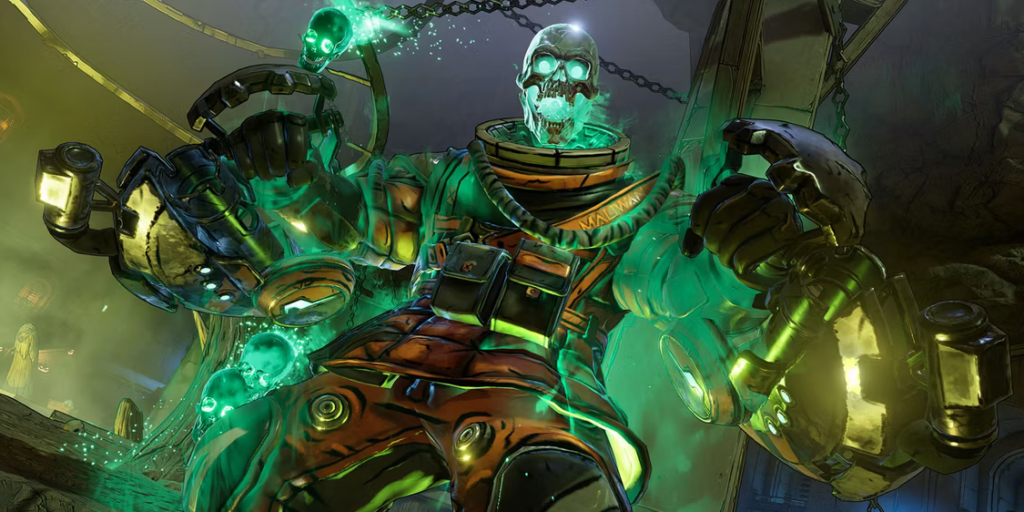
To congratulate Wooga on June's Journey's impressive $1B lifetime revenue milestone, we make this deconstruction public for the first time. It is from Naavik's archives, and was first published in October 2022.
Recently, the number “5” has been involved in some important milestones for Wooga, the creators of June’s Journey. The world’s most successful hidden object game on mobile is celebrating its 5-year anniversary this month while having grossed $500M in revenue. The game is by far the company’s biggest hit, and it has successfully surpassed all of its direct competitors. It’s time for a long overdue look at this beautifully crafted murder mystery.
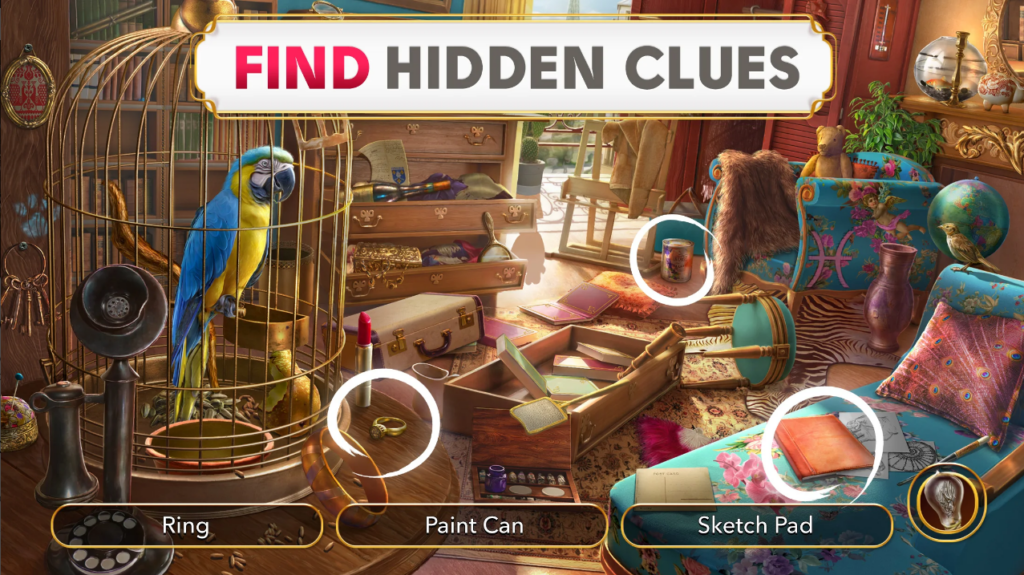
First, let’s take a look at June’s Journey’s performance and the hidden object subgenre as a whole. The game’s revenue has been consistently growing, even though downloads remain relatively flat, while maintaining a healthy all-time RPD increase. The updated RPD is $7.73 (on iOS), which does not even count the game’s significant amount of ad revenue.
Let’s start with a little history: Wooga was founded in 2009, and its first hits — Brain Buddies, Bubble Island, Monster World, and Diamond Dash — were all Facebook-first hits. From 2013 onwards, the company pivoted to being mobile-first and released what would be its two biggest hit titles for a long time: Pearl’s Peril and Jelly Splash. These two games, together with Diamond Dash, have been Wooga’s main sources of revenue up until June’s Journey’s launch in 2017.

As early as the launch of Pearl’s Peril — June’s Journey’s spiritual predecessor — Wooga unknowingly discovered what is now its main strength: creating high-fidelity and story-driven hidden object games. Without Pearl’s Peril unleashing the combination of episodic hidden object content on one hand, and island decoration on the other, June’s Journey would have never seen the light of day.

The hidden object genre has always been niche, and it has proven to be Wooga’s key market segment to this day. Especially after the company announced its vision to become the market leader in creating story-driven casual games in 2018, no other subgenre has been more suitable to fit its ambitions. The visual storytelling in this genre is unequaled due to the ability to paint beautiful scenes even within the core game. Whereas other puzzle games struggle to combine the stories in their meta games with highly abstract challenges at their cores, hidden object titles have the potential to become something much more immersive and meaningful.
However, creating these games has not proven to be an easy path to success at all. Monetizing players without a loss condition is a tricky endeavor; companies like Playrix even pivoted away from hidden object, changing the core of one of its most prominent games, Gardenscapes, to level-based puzzles at the last moment. At the start of the Covid-19 pandemic, Playrix took another stab at the genre by combining its answer-to-everything mansion decoration meta with a hidden object core. This resulted in Manor Matters, which achieved profitability but has been suffering from a heavy decline a bit more than a year after its launch. Even genre-expert Big Fish has not been able to translate its expertise from browser-based hidden object games into mobile success.

The magnitude of June’s Journey can easily be described as monstrous, which is why so many competitors have failed or refrained from trying to replicate it. While Manor Matters and June’s Journey have some overlapping features (like their core gameplay and alliterated titles), the two games are incredibly different. The (worst-kept) secret that makes this genre so difficult to penetrate — and what has been key to the success of June’s Journey (and the demise of Manor Matters) — is narrative. Whereas games with the decoration loop usually have paper-thin stories tacked on with practically zero character development (with rare exceptions like Lily’s Garden and Love & Pies), June’s Journey is truly story-driven, releasing a weekly chapter of fresh narrative since 2018 without fail.
Now, it’s not a secret that a big part of the mobile audience does not seem to be interested in narrative arcs, but the other part of the audience that is looking for narratives is incredibly loyal when they find a story they identify with. This is especially true for the audience that Wooga has found with June’s Journey, which predominantly consists of older women.
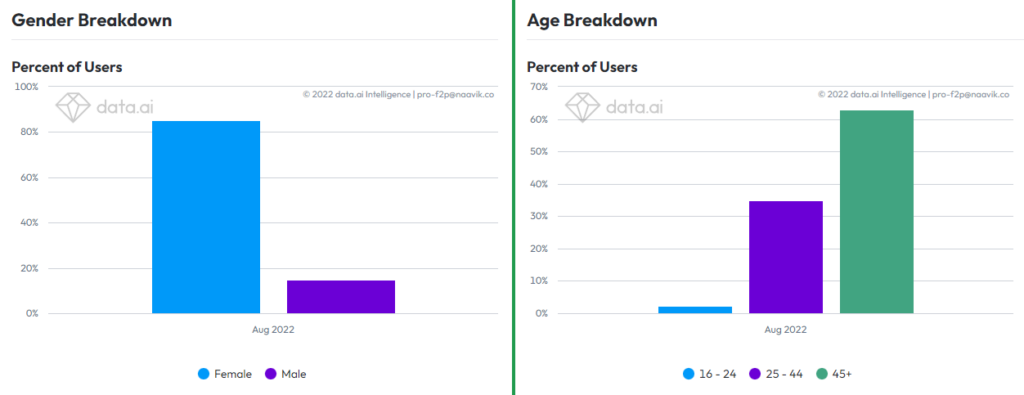
On a more personal note, as an advocate for engaging narratives in any medium, I don’t think that the strong appeal of the game’s setting to its audience demographic (New York in the roaring ‘20s) is the single unique factor to its success. Only stories deep enough to bring forth interesting stand-alone fiction outside of the game are able to drive it forward and make players invested in what’s next. We haven’t seen many great casual game examples of super engaging narratives yet, but games like June’s Journey show it is doable.
However, even games with smooth core gameplays, great audience fits, alluring storylines, and fun, decorative metagames don’t naturally retain players for years on end. In June’s Journey’s case, the game’s steadily increasing RPD has been correlated with its growing arsenal of strong live-ops features. In fact, June’s Journey is a perfect example of how a high-potential hit game can steadily grow to be #1 in its genre through engaging live-ops and community management.
This article will shed light on this thesis by:
- Comparing the June’s Journey core gameplay to the competition it surpassed
- Analyzing its core, loop, and content pipeline
- Listing its base features
- Breaking down its live-operations
- Covering examples of its best-in-class community management
- Pondering what the future holds for Wooga
Let’s jump in…
Unique, Stressless Flow
Traditionally, hidden object games like MYTONA’s Seekers Notes and G5’s Secret Society built their gameplay around loops that focus on level performance. Rounds in these games have decreasing time limits and increasing numbers of objects to find. These games have only about 30 scenes in total, but the same objects can change places with every round by being assigned one of several pre-placed locations within the scene. Combined with many different gameplay variations, like spotlight mode, word jumble, mirror mode, or pair matching, the scenes in these games stay challenging and replayable. The player is not able to master them by remembering the locations of all objects within.

The gameplay in June’s Journey does not follow this decade-old hidden object structure, but instead actually allows for mastery through scene-specific progression. Objects have only one fixed position, and scenes never change game mode. The goal is the same every single time: find all listed objects. To perform well, players should find about 10 objects in steady cadence, which is visualized by the combo bar at the top. If they lose their combo, players lose points, which ultimately leads to more replays until the scene is mastered. For achiever player types, these points also allow for some light competition in the form of a high score in each scene’s leaderboard.
Except for the soft nudge towards timed performance that the combo bar provides, there is no time limit for a round of gameplay and therefore no loss condition either. The only challenge the player faces is new objects appearing after a few rounds, but they have all the time in the world to find them. In case of struggle, a free hint can be used every 30 seconds. This provides a unique, peaceful gameplay you can’t really find anywhere else in the hidden object genre.


The Episodic Pipeline
Because the scenes in June’s Journey are completed when mastered, continuous production of new ones has become a requirement. This sounds like a big commitment in terms of content production, which it is, but it’s also one of the game’s unique strengths. Its new episodic content consists of one weekly released chapter. The addition of these chapters requires no client updates, as no new gameplay nor features are introduced. The fact that a company’s development team would be required to deliver a handful of hand-painted, high-fidelity scenes every week is one of the reasons why many developers have not dared to create a game like June’s Journey.

Initially, the game was supposed to stop after 100 chapters, but following its success, Wooga decided to keep the story going and announced a second volume. Fast-forward a few years, and Volume 6, Chapter 30 came out recently. Volumes 1-5 contain 100, 50, 25, 35, and 35 chapters, respectively. When you add in Volume 6, this totals 275 chapters at the time of writing. That means the game currently has over 1,375 unique hidden object scenes and 275 hand-crafted puzzle scenes to boot. The game’s episodic content is linked together using 6,050 dialogues between members of its varied cast (all of Volume 1’s dialogues can be viewed here). The power of the free-to-play model really shines through in June’s Journey, as any new player starting today can enjoy years' worth of quality narrative content free of charge.
The effect of this episodic content cadence can be seen in the game’s retention numbers, with a curve that becomes extremely flat after day 30: 16.5% of players are still playing at this point. On day 60, the number is still 15%, and by the time day 180 rolls by, practically all these people are still playing, as the retention rate has only dropped by 0.75% over those 120 days! As a comparison, long-term retention rates of G5’s Hidden City are around 5% lower for any of these points.
The Island Loop
Contrary to its aforementioned competitors, June’s Journey (and Pearl’s Peril before that) has a unique game loop with metagames focusing more on steady progression and customization than on performance. The loop can be visualized as follows:

The player spends their energy bar (which can be extended for diamonds) to play scenes. Finishing scenes awards Coins and Star progression (finite). Coins are then used to decorate the island. Every new decoration or building awards Flowers, which in turn unlock new scenes to play.

Target Audience
The non-punishing core, the episodic content, the narrative setting, and the decoration on the island all result in a flow-inducing gameplay that’s suitable for a unique target audience. June’s Journey has a predominantly female and older playerbase. Whereas puzzle games like Candy Crush Saga are played more by millennials than by older generations, June’s Journey’s direct competitor, Hidden City: Mystery of Shadows, has a more equal, almost 50/50 division. Surprisingly, Bingo Blitz players are even slightly younger than Hidden City’s audience, but within June’s Journey, by far most players are Generation X or even the older Boomer generation.
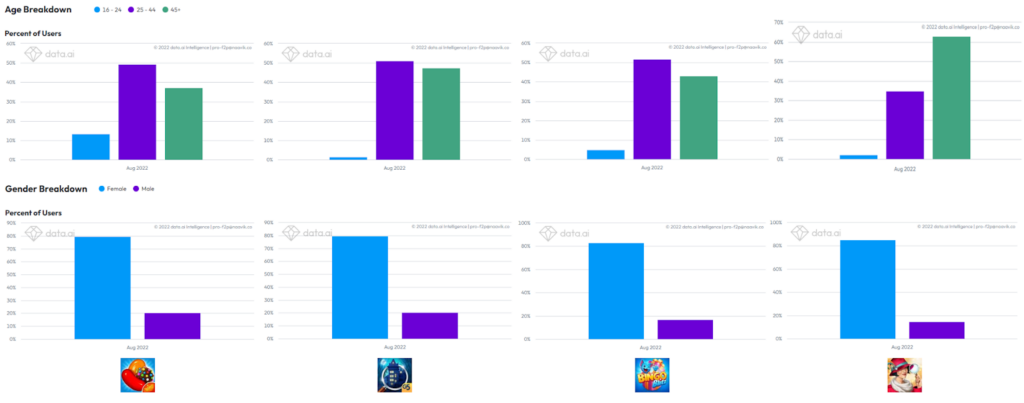
More specifically, almost half of June’s Journey’s players are over 60 years old, and 85% of the playerbase is female. Therefore, it’s only logical that along with the game being available on iOS and Android (tablets), it’s also playable on Facebook (through WebGL) and Amazon. Given that older generations around the world generally have a lower English proficiency, the game is localized in 20 languages, including Norwegian, Polish, Danish, Dutch, Latin-American Spanish, Korean, Arabic, Bahasa, Mandarin, and Cantonese.
The game’s user acquisition has historically been driven mostly through Facebook, but since Apple’s notorious decision to deprecate the IDFA, and even a bit before that, the efficacy of this method has started to stagnate. To counteract this, Wooga has been experimenting with other means of advertising since 2020, including prime-time TV commercials targeting the US audience the game mainly serves. Safe to say, the perfect solution to reverse this trend has not yet been found.

Feature Breakdown
The game has received many new feature updates over the years. In the following paragraphs we will concisely break them down and see how they benefit the game.
Landmarks
These stationary buildings on the island provide the player with a daily supply of progression in the form of Flowers. As landmarks are the only source of free Flowers, coming back to the game just for the simple task of tapping a button to upgrade them is a no-brainer.
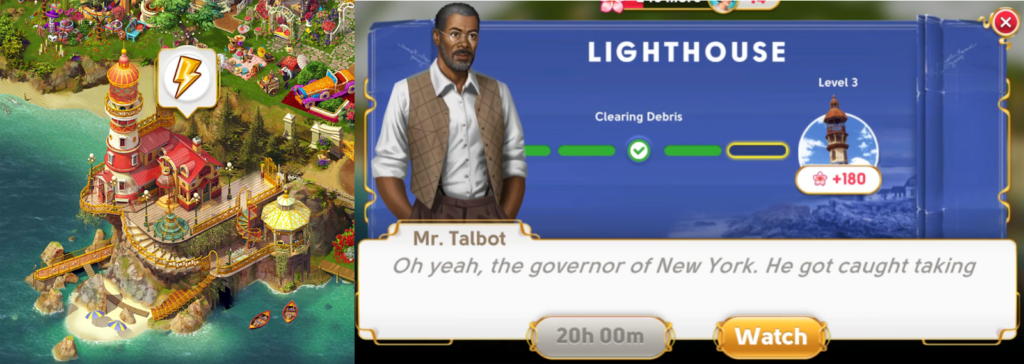
Every day, players can earn one batch of free Flowers by filling two bars, but only the first one is free, and the other can be filled by watching an advertisement. Therefore, the trade-off of maintaining a good speed of progression by watching one advertisement is another no-brainer. On top of this, player progression stays balanced through a steady flow of instant Flowers. As the landmarks provide a very significant sum each day, it creates a rubber banding effect between engaged players and occasional ones.
The first landmark — the Lighthouse — contains 20 levels, each taking about 2 weeks to complete before the building is visually upgraded. The game contains four landmarks, each taking months of daily logins to complete. Renovating all of them takes about two years. After the player completes all landmarks, a special, fifth landmark is unlocked, allowing for infinite progression by releasing animated flocks of birds onto the island instead of new buildings that need renovating.
Help Wanted - Challenge Tasks
This feature provides the biggest amount of rewarded video placements in the game. A permanently available newspaper asks the player to complete tasks in exchange for Energy or Coin rewards. Additionally, after completing enough tasks, the player wins a reward box containing more valuable prizes.
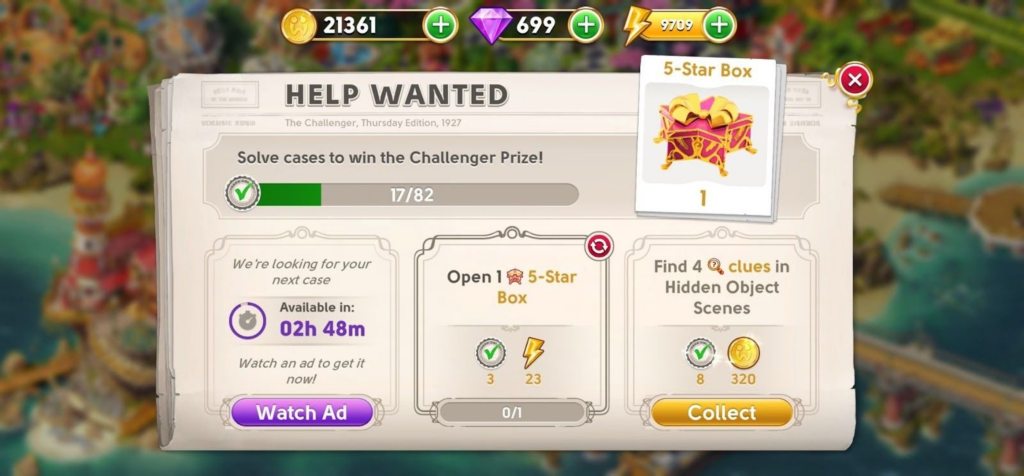
The smart rewarded video placements come in after the player completes a task and gets rewarded (which is a great moment to ask them to commit to something, by the way). They can choose to wait (3, 8, or 16 hours, depending on the size of the task) or watch one video to skip the entire timer. Especially for bigger tasks, it’s much more efficient to watch the ad and start working on the next task right away, as most of the tasks can be accomplished by progressing through the game normally.
To boost engagement temporarily, the feature also has short bonus times where, for a couple of hours, the player earns more points for completing a task and the chase prize is doubled.
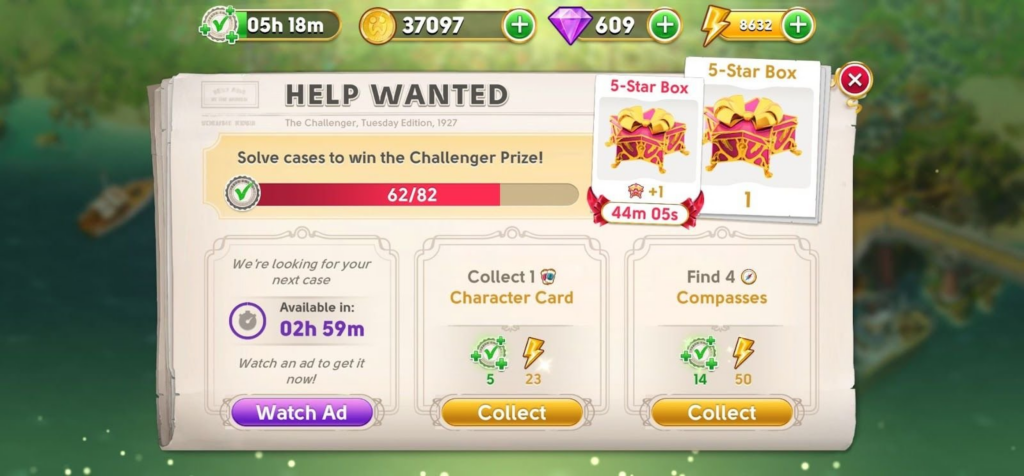
Photo Album
Narrative is a big part of June’s Journey, and every character has a backstory. When the game launched, none of the more modern methods of world and character building (e.g., its own dedicated podcast) were in place. The first feature that focused on this aspect, whilst providing the developers with reward space for the game’s Star Boxes, was the Photo Album. When players find enough character cards in reward boxes, they can complete a puzzle to finish a photo, which awards them with one bar of energy and a bit of backstory about one of the game’s characters.
A Unique, Multi-layered Social System
Something that doesn’t immediately come to mind when building a hidden object game, especially one like June’s Journey with such a mature audience, is its social drivers. When asked, a big part of the playerbase most likely would not have answered positively to the question of whether they’d be interested in collaborative multiplayer functionality. And yet, years later, the game has proven that its audience is ready to engage not only in low-threshold interactions like gifting but in full-blown team management, competitions, and elaborate social synergy, such as meeting up at specific times during the day.
Visiting and Gifting Bushes
The first social feature that was added to June’s Journey is the bush gifting system. Instead of the boring old gifting of lives (energy in this case) or coins, here, the player has to actively engage with other player islands by visiting them first. By taking the boat, players can visit and view other people’s islands and plant a bush every day. This incentivizes them to interact with and ‘decorate’ other islands, which in turn could inspire the visiting player with decoration ideas.
Gifting plants costs some coins, but when the receiving player removes them, they can generate several gifts, including rare hard currency (gems). This system incentivizes players to keep reciprocating to the same players, creating an unspoken bond between them that can last for months or even years.
To allow people to visit each other’s islands or see their scores in the leaderboards, the game bundles players together in anonymous groups by masking their names and avatars (in case they play via Facebook). Then, players can choose to invite the ones they have a reciprocal relationship with to the next level of the game’s social system: Detective Clubs. These clubs are the heart of June’s Journey’s social system. The system enables players to engage with a whole array of social features that we’ll explore more in depth.
The Detective Lounge
When joining a club, players can start chatting with other club members and share virtual drinks with each other once a day. This unique energy-gifting system requires players to come online at approximately the same time, as drinks posted in the Lounge are only there for 30 minutes and can be used once by every player.

To optimally gift drinks, players should do it when as many club members as possible are online. This enables all club members to enjoy everyone’s drinks, which results in at least one bar of extra energy when done right. For this purpose, each club can configure its own, specific ‘meeting time’ parameter, indicating when to come online each day. Additionally, every time a player consumes a drink, the gifter receives tips, which can be traded for profile avatars, different drink skins, or an increase in energy the drinks provide.

Club Competitions
With all this extra energy, the drink gifting could be dangerous for the game’s energy economy. Players are able to accelerate the speed of the episodic progression, but where there’s a source, there’s a sink! Enter the Club Competitions.
About twice a week, players have a little more than a day to play non-classic hidden object rounds for a maximum of 45 minutes. During this time, players try to rack up as many points as possible by playing increasingly challenging, time-limited rounds of Spot the Difference or Time Rush. These special game modes do have a timer that provides a soft loss condition, and they were clearly inspired by the aforementioned competitors that use timers within their core gameplay.
These timed trials provide the players in a club with “coopetition” to try and best other clubs in the temporary club leaderboard specifically created for the competition. All members of the highest ranked clubs earn valuable rewards like hard currency and the cherished compasses.
Detective Leagues
Finally, the social loop comes full circle by awarding players who take part in the club competitions with League Points. Additionally, players also rack up League Points through the single-player Help Wanted challenges. In stretches of several weeks, player clubs try to climb the League ladders by promoting through increasingly competitive divisions.

Whoever thought that 60-year old women wouldn’t be looking for online competition at scale should think again. The June’s Journey community is full of highly competitive groups of players managed by ladies who sometimes are just as fanatic as the average World of Warcraft guild leader. It’s a remarkably successful attempt to make online, competitive gaming accessible for a demographic that has rarely been exposed to this elsewhere.
Live-ops
The components above are all part of the game’s permanent feature set. But this does not include any of its live-operated events that come and go periodically. After years of additions, June’s Journey truly caters to every player type as more and more meaningful elements were added. Up next is an overview of the game’s live-ops over the years and the impact they seem to have had.
Seasonal Sets
One of the interesting things to note when looking at June’s Journey is the lack of a traditional season pass. The reason for this is that the only live-ops feature that was implemented since launch has been fulfilling this need already. As the game’s meta is built around the grid-based beautification of its island, a monthly set of seasonal decorations is rotated in the game’s store of isometric items.
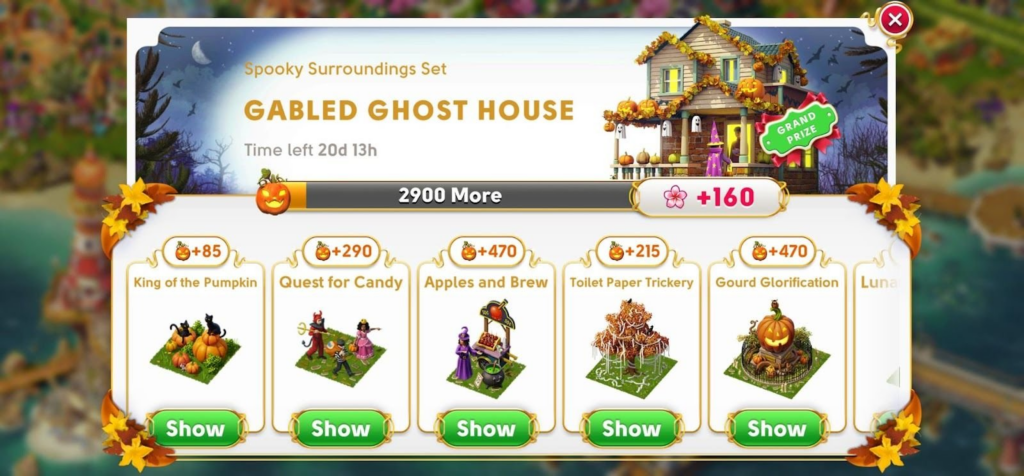
Every month, players are challenged to purchase enough decorations from the set before the event ends. Seasonal decorations cost coins just like non-seasonal, permanent ones but additionally grant seasonal tokens upon completion. After engaging enough, players receive that month’s special Grand Prize decoration. Seasonal sets of decorations with themes like Easter, Japan, snow, and Halloween recur yearly with fresh new objects and a new chase prize to collect every time.
The fact that the game is that old and players keep owning assets regardless of their age means that veteran players have unique legacy decorations that haven’t been available for purchase for ages. For this reason, the game provides highly esteemed vintage decorations, some selling for in-app purchases or outlandish Coin prizes.
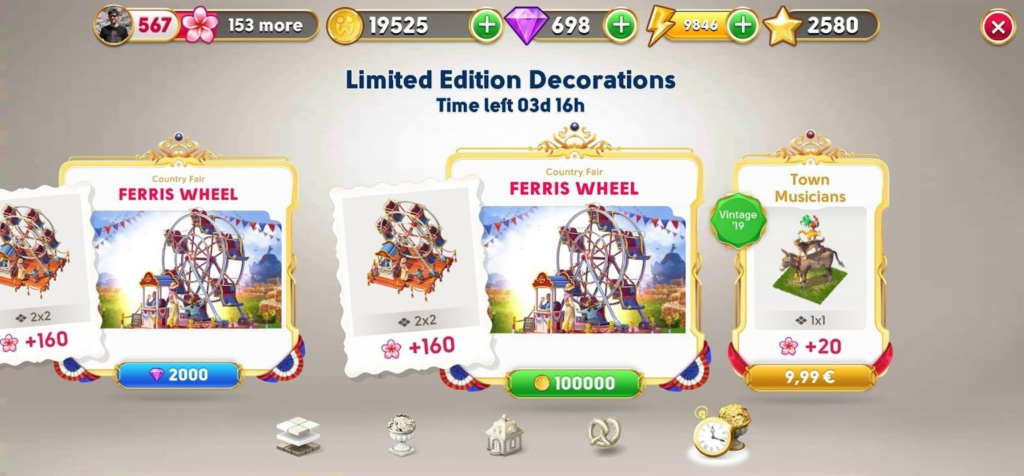
Memoirs
Until August of last year, June’s Journey didn’t have a huge amount of reward space. Where other more competitive or skill-based games are able to reward players with boosts, the relaxed pace of June’s Journey didn’t allow for a lot of desirable, time-limited items. But during that fateful month, a new feature with the purpose of solving this issue once and for all was released.
During one cycle, for a long period of time (more than two months) players are occasionally awarded card packs. These packs contain Memoirs (objects with five different rarities), and players place these objects into special scenes they belong to until they are completed. This is the game’s gacha mechanic, which has always been a great way to facilitate additional reward space. It’s especially useful when players need to be given high-value rewards, since packages with higher drop rates for rare Memoirs can be given away. As is customary with more elaborate gacha systems, the player is able to find duplicates and transform them into the last missing pieces to complete their collections.
However, one thing that similar systems ultimately require is a desirable chase prize, and Wooga has found a good way to provide it without taking space on the decoratable area of the island. By completing every collection of Memoirs, players can unlock permanent phenomena on their islands. Examples of prizes include dolphins, humpback whales, and a sailing boat in the waters around the island. Other past rewards included a coastal wedding ceremony and a sandy, umbrella-filled cove with visiting beachgoers.
Celebration Event
Orchid Island contains a festive gazebo that’s utilized for countdowns towards celebratory moments like Christmas or Easter. For the most recent example, with the approach of the game’s 5th anniversary, the building again gave access to an anniversary-themed daily giveaway feature with a unique, celebratory decoration as reward on anniversary day. To guarantee daily engagement, players are required to finish a number of scenes before being able to claim the daily prize.

Detectives Needed
Occasionally, a straightforward, time-limited event is triggered, providing extra chase rewards in exchange for more-than-average engagement with the core game during the 48 hours it’s active. After reaching specific milestones within, players can choose their reward.

Sweep the Board
While the Detectives Needed event was implemented relatively early on, there hasn’t been much variation in terms of engagement-boosting events — not until July 2021 at least, when the Sweep the Board event was released. Throughout this event, the player traverses a board-game-like space which requires them to play 4 scenes with 10 rounds each. The scene progression acts like a checkpoint every time a new scene is reached. When the player completes a round, rewards are added to their stash. The trick is that these rewards are only awarded to the player once they reach the checkpoint introducing the next scene of the event. If the player fails a round before that, the game pushes their tendency for loss aversion by showing them their stash upon asking them if they are sure they don’t want to pay hard currency to keep them and add extra time. If not, players are reset back to the last checkpoint.
This time-limited event is unlike the rest of the game’s features, as it is the only one that actively pushes players to the max by requiring a very high amount of skill and commitment to be completed successfully. As opposed to some of the other features that were described above, this one wasn’t received very well, most likely due to its aggressive nature. Consequently, it doesn’t seem to have had a positive result on the game’s revenue.

Fairground Fortune
The latest tool in the game’s live operations toolbox has the purpose of giving the player additional, temporary tasks to strategize around. Through the aesthetic of a bingo wheel, players get granted six prizes if they perform a combination of three assigned tasks enough times. If they succeed, they win a small decoration as the chase reward.
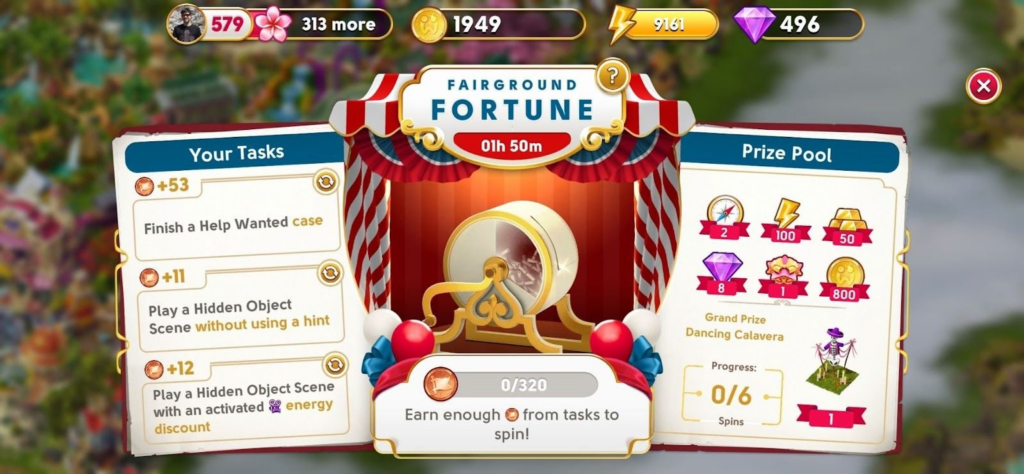
The feature was rolled out at the start of 2022 and clearly shows Wooga’s focus on extending the session length and overall engagement of its existing playerbase with additional spend as the desired side effect.
Sales
As any adult live game, June’s Journey contains a good amount of sales and monetization strategies, like frequently selling bundles of currency, usually combined with an exclusive isometric decoration. The newest addition to the game’s remunerative array is the vault, which is the classic example of a piggy bank.

One last example of a feature that’s exclusive for premium players is the loyalty card (also recently implemented), tempting players into consecutive purchases in exchange for surprise rewards. Also, note the added bonuses in the store screenshot below, all adding to the feeling of timely opportunity when choosing to convert today.

Community Management
Having such a senior and dedicated audience for your game opens lots of doors. Of course, there is the monetary aspect; lots of these players have adequate balances on their bank accounts, but the more important door is the one to their hearts. Compared to the entire gamer audience, these older women are relatively underserved. Providing them with a sense of community can turn them into probably the most loyal, dedicated advocates of your game. This has to be anchored mostly through the numerous social features discussed above. But the last step to really glue everything together is great community management. In this aspect, Wooga has been an example for the entire games industry with a continuous cadence of how-to videos, additional fiction, behind-the-scenes content, and community contests.
The most elaborate community contest was without a doubt the Hidden Talents competition that the company did for the game’s 2nd anniversary event. It all started when Wooga released a video requesting players to submit a video of them sporting one of their (hidden) talents. From the submitted material, five winners were selected and flown to Berlin for an all-expense paid trip to meet the team and each other while being shown around many of the city’s attractions. The result was a series of incredibly wholesome, heart-warming videos for the community, and a once-in-a-lifetime experience for the five lucky winners from around the world.
For June’s Journey’s latest anniversary, The Challenger (the game’s mailing list) has been promoting a contest in which players are asked to solve a mystery — entirely outside the game — regarding one of the characters’ heirlooms being stolen. As a reward, a random selection of 5 players who solved the mystery correctly will be sent a 14-carat gold bracelet.
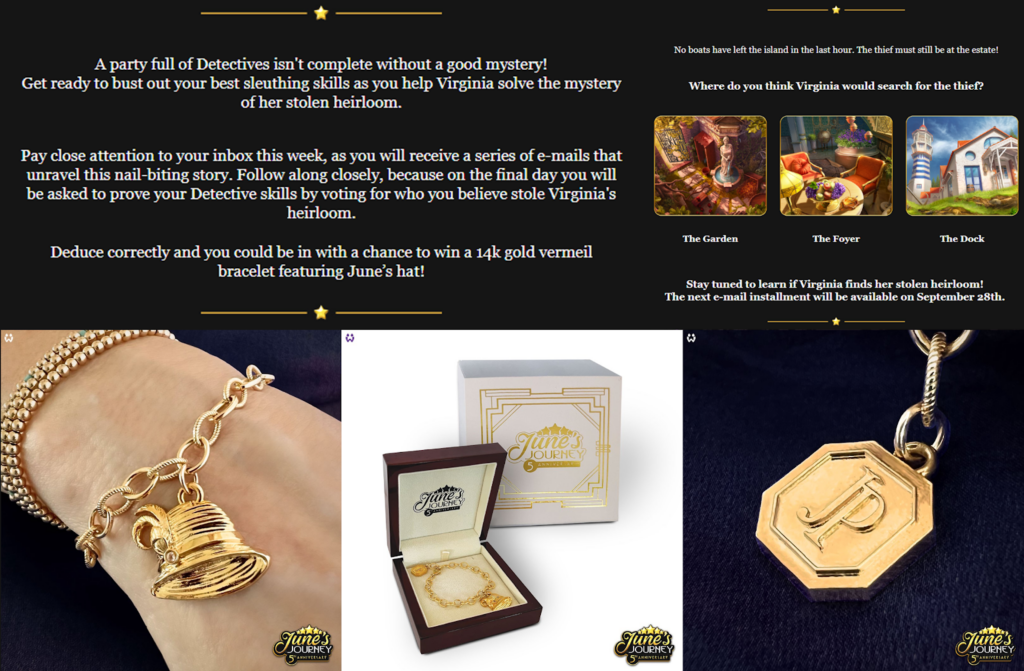
As Facebook is the most prominent platform for the target audience, Wooga community managers post daily on the game’s official Facebook page and help manage the countless other fan pages on the platform, all driving lots of engagement or in some cases even strong, intercontinental friendships. Posts in these communities are often a delight to read as this audience is one of the most vocal demographics of people in the world (so vocal that the company can directly post community videos of a Decoration Masterclass by hyper-engaged players).

Lastly, as has been advertised in the countless non-June’s-Journey videos on Wooga’s YouTube channel, the company has been decisive and forward about sustainability and climate change by operating its business on a climate-neutral basis. Additionally, the company has linked in-game tree planting in June’s Journey and Pearl’s Peril to planting trees in real life. June's Journey players succeeded to reach the targeted number of planted trees within a mere 90 minutes.
Damocles, anyone?
As it goes in any industry, companies ending up on a downward trend run the risk of being eliminated. For example, when its sister company, Seriously, got shut down by their mutual parent company, Playtika, Wooga saw how things could go if it ended up in a similar scenario.
One thing that is worrisome about Wooga’s future is that it has failed to release another successful game since June’s Journey’s launch in 2017. Currently, the game is one of Playtika’s most sustainable and lucrative assets, but even the biggest hit games have limited lifespans. However, being the biggest game in its genre, June’s Journey definitely has quite a couple of years to go, as Candy Crush Saga proves by being exactly twice as old. A caveat here is that Wooga, and Playtika even more so, should be stringent to not get greedy and keep respecting the audience by refraining from adding increasingly predatory systems into the game’s feature set.
Regardless of the recent failure of Switchcraft, Wooga will keep trying to diversify its portfolio while still dominating the hidden object market by releasing new, successful games in the genre. Wooga’s new hidden object game, Ghost Detective, soft-launched in B-countries at the start of 2022 and in selected A-countries like the Netherlands, Ireland, and Canada last summer.
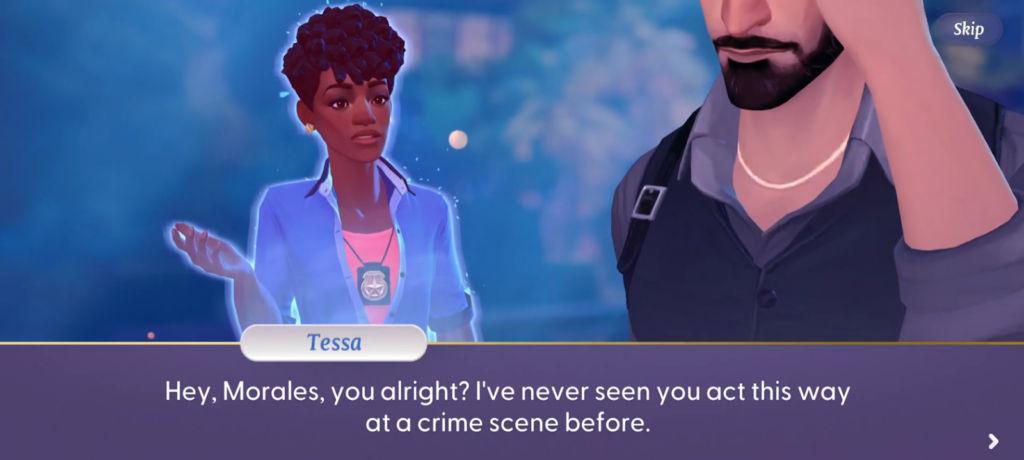
Granted, it’s still too early to tell as its RPD currently floats around $0.30, but the game is not a guaranteed success by far. Its mysterious, light horror theme is a less likely audience fit to the company’s most loyal players. Additionally, times have changed, and user acquisition has become less straightforward compared to when June’s Journey launched.
Regardless of Ghost Detective’s future, the most reliable way to save Wooga is to stay on course and follow the direction the company outlined in 2018: creating deep, narrative-driven experiences. For this reason, Wooga should acknowledge that its last successful mobile puzzle game was released almost a decade ago and that this segment probably isn’t the most scalable direction for its narrative-driven strategy. Along with releasing new hit hidden object games, diversifying into other genres that allow for a natural narrative integration is key. Detective games like Duskwood or The Girl in the Window come to mind. Another fresh direction could be the Room Escape subgenre (with games like Prison Escape Puzzle) or the June’s Journey puzzle scenes to take inspiration from. Lastly, it’s a bit of a stretch, but there might even be options to innovate and try bringing a meaningful narrative to casual role-playing games like Empires & Puzzles or Archero! It’s all possible as long as new, story-driven hidden object successes keep coming.
A big thanks to Niek Tuerlings for writing this essay. If Naavik can be of help as you build or fund games, please reach out.




